Reptile Restraint Techniques for Veterinary Technicians
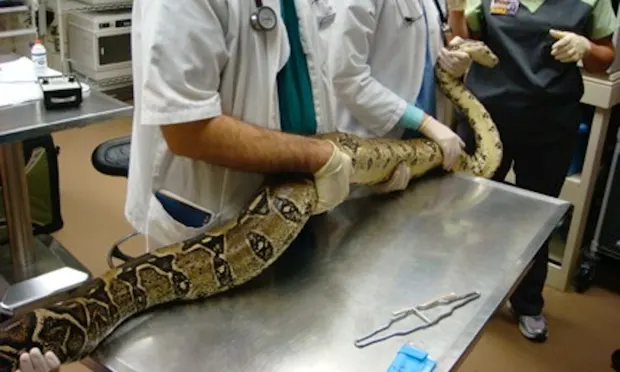
The key to safe, appropriate restraint of reptiles is having a basic knowledge of the behavior of the patient’s species and the temperament of the individual animal.
Most reptiles possess a defensive rather than offensive attitude when feeling threatened. They can be very perceptive of their environment and can even form bonds with owners, so it is important to provide a calm, nonthreatening environment. Loud noises, sudden movements, noxious smells (eg, lotions, perfumes), and table vibrations are examples of environmental stimuli that may adversely influence a reptile’s behavior in the practice.
The first rule of reptile restraint is to know the animal’s defense systems. Regardless of species, make sure all reptiles are fully supported while being restrained to make them feel more secure.
Related Article: How to Restrain Pets Appropriately in Front of Clients
Snakes
A snake’s main defense system is its bite and ability to constrict. Keep in mind that snakes have incomplete tracheal rings, so when restraining the head and neck, one must be careful not to collapse the trachea. Venomous species should strictly be handled by those with training and experience.
The first rule of reptile restraint is to know the animal’s defense systems.
Most snakes have a keen sense of smell and are able to detect a remnant of prey species on a handler’s hands. Wash your hands thoroughly before handling snakes, especially if you were previously working with small mammals.
Wearing gloves can also help mask mammal smells that may cause a snake to strike. Although it is common practice to immediately restrain a snake’s head, this may not be necessary in mild-mannered animals; for example, ball pythons and corn snakes can usually be restrained by simply supporting their bodies with both hands. Therefore, it is important to know the species as well as the individual patient.
Constrictor species may be more likely to strike, followed by an attempt to constrict around the handler’s arms or neck. These species are best handled by controlling the head first, followed by supporting the body.
Two techniques can be used to restrain the head. One is to place the thumb on the ventral mandible while the fingers are placed on top of the head, using the pinky finger to support the neck. This technique may be better suited to larger, more active snakes.
The second, which is useful for smaller or more docile snakes, is to simply hold the head or neck from the sides without exerting pressure on the dorsal or ventral aspects (Figure 1). In larger constrictors, a firmer grip may be required.
Figure 1. It is possible to restrain a snake by holding the neck from the lateral aspect with the thumb and forefinger. This technique applies little to no pressure to the trachea. This snake had obvious stomatitis, which would require debridement of the area and lead to direct exposure to bacterial and/or fungal organisms; hence gloves are worn.
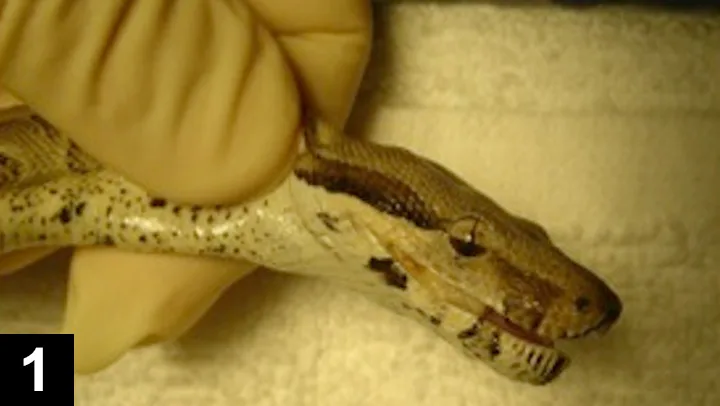
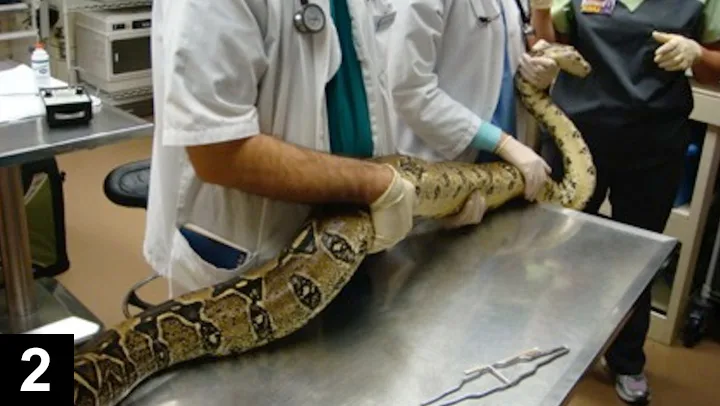
Figure 2. A large constrictor snake’s body is supported by an examination table and 3 handlers. Notice that the head is loosely restrained by wrapping a hand around the neck. This technique can be safe in mild-mannered animals but handlers should always be vigilant. Because the snake was about to undergo a trans-tracheal wash, which often results in exposure to fluid-containing bacterial organisms, gloves are recommended to minimize exposure to pathogens.
Lizards
Most lizard species are unlikely to bite during an examination, with 2 exceptions: green iguanas and some monitor lizards. Green iguanas can bite, claw, and use their tails to inflict potentially serious injury. Monitors are more likely to bite. Protective gloves (ie, welding gloves or gauntlets) and a towel can be used to safely restrain these lizards. Place the towel over the lizard’s head and block its view, which will allow the handler to quickly hold the neck and body to secure the animal.
Related Article: Stress-Free Restraints and Handling
Other lizard species can simply be picked up and placed on the palm of the hand. When restraint is necessary, place one hand around the neck area and support the back legs and tail with the other.
Figures 3-6 illustrate various restraint techniques in lizards.
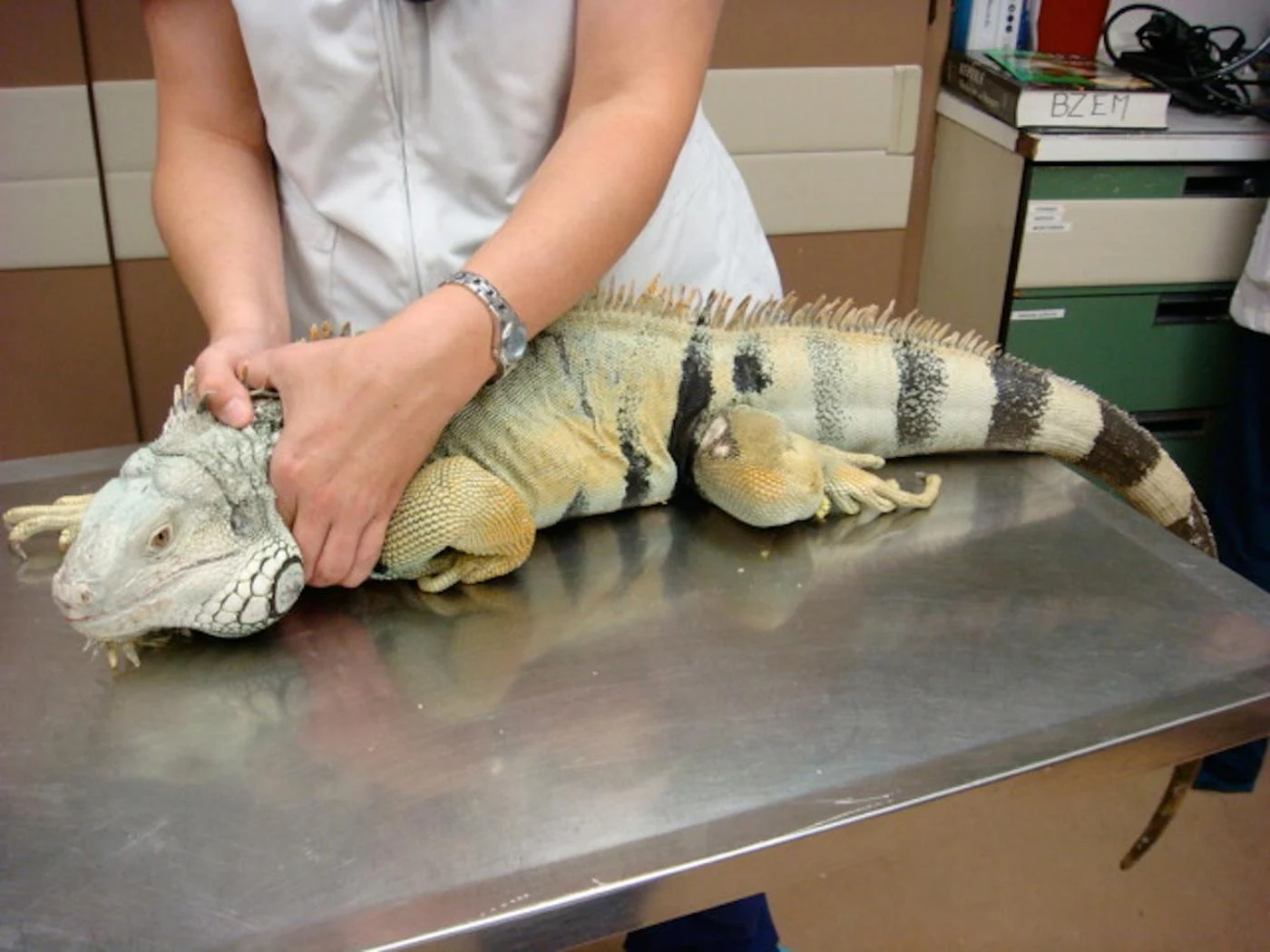
Figure 3.
An adult male green iguana is restrained for a simple physical examination by holding the neck with both hands while the animal rests securely on a table to support its body.
Chelonians
Chelonians are generally shy, defensive animals and are unlikely to bite, with sliders, snapping turtles, and soft-shell turtles the exception. Snapping and soft-shell turtles can stretch their necks up to half the length of their shells; therefore, handle these species from the rear third of the body, controlling the head if possible (Figure 7).
Figure 7. A soft-shell turtle’s head is restrained for a simple physical examination by grasping its neck with a full hand while the body rests on a table for support. This species is prone to biting and the long necks can reach up to 50% of the length of the carapace; therefore, head restraint is essential for safety. Notice that the front limbs can grasp the table edge, which may allow the animal to attempt escape by pushing against the table. The handler must be aware of this and support the body to prevent an accidental fall. Gloves are worn because the animal was covered in mud.
Tortoises are less likely to bite, but will retract into their shells when threatened, which can injure human fingers trapped inside the shell space.
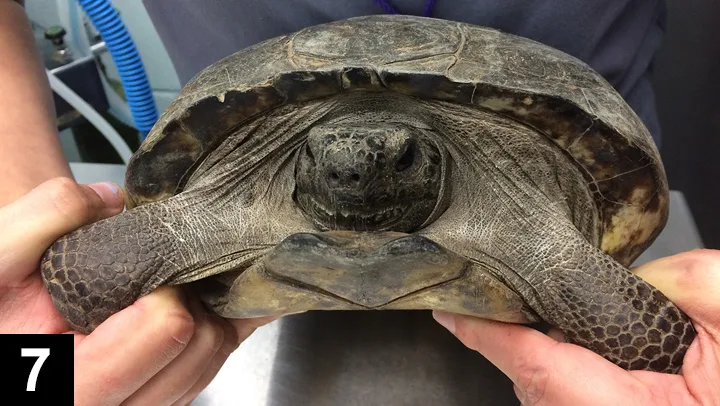
Chelonians can be restrained by simply holding their shells. When access to the head is needed, both front limbs can be pulled backward to allow visualization of the front end (Figure 8).
Figure 8. A gopher tortoise is restrained by its front limbs to observe its head and its body’s cranial aspect.
Crocodilians
Crocodilians can inflict serious injury and their bite can lead to local or systemic wound infection, so restraint is better left to those with experience. The author recommends that one team member be available for every 3 feet of animal when restraining crocodilians in a practice setting.
Author’s note: It is extremely important that any veterinary team member handling reptiles wash his or her hands before handling reptiles (to prevent cross-contamination across patients) and after (to prevent spread of zoonotic diseases and cross-contamination to other patients). Hands should also always be washed after working with any animal, even when the handler wears gloves. Research has shown that wearing gloves can give the handler a false sense of security, and wearing gloves alone is not sufficient to decrease microbial contamination, and using good hygiene (ie, hand-washing) is scientifically sound.1-3 Of course, any immune-compromised handler should wear gloves as extra protection.
(All images are ©Javier Nevarez, DVM, PhD, DACZM, DECZM (Herpetology), Louisiana State University School of Veterinary Medicine.)